|
Retention of knowledge within the
private sector organizations in the
Kingdom of Saudi Arabia

Alshanbri,
N.
Khalfan, M.
Maqsood, T.
RMIT University,
Melbourne,
Australia
Correspondence:
Malik Khalfan
RMIT University,
Melbourne,
Australia
Email: malik.khalfan@rmit.edu.au

Abstract
This paper presents a brief literature
review of knowledge and explores the
role of Knowledge Management (KM)
and Human Resources Management (HRM)
both in sustaining Intellectual Capital
(IC) within an organisation, particularly
in the context of Nitaqat Program
in Kingdom of Saudi Arabia (KSA).
Based on the literature review, it
argues that a new worker could be
transformed to a knowledge-worker
if appropriate transition processes
were in place for knowledge retention
and capture from an out-going employee.
This paper presents the findings from
the interviews undertaken with both
local and non-local employees in the
private sector in KSA and reviews
the impact of Nitaqat Program resulting
in knowledge sharing and management
of sticky knowledge between non-local
employees leaving the companies and
local employees taking their positions.
Key words: Knowledge Management,
Knowledge Sharing, Human Resources
Management, Employees, Nitaqat, Kingdom
of Saudi Arabia

Introduction
Knowledge has two widely known formats
which are explicit and tacit as defined
by Polanyi (1964). Explicit knowledge
can be expressed in words and numbers.
This format can be easily shared and
transferred between people in many
forms like data, specifications, manuals,
etc. On the other hand; tacit knowledge
which is often difficult to share
or transfer comes in forms such as
insights, intuition, and hunches.
In order to transfer tacit knowledge;
it needs to be converted into an explicit
form. Nonaka (1994) identified four
possible ways for Knowledge transformation
from one form to another; these ways
are Socialization (from tacit to tacit);
Externalization (from tacit to explicit);
Internalization (from explicit to
tacit) and Combination (from explicit
to explicit). Nonaka (1994) also defined
the Externalization as the way of
converting tacit knowledge into words
or visual concepts to make it easier
to be understood. The previous methods
can transform knowledge forms from
one to another but sometimes it is
hard. When Knowledge is hard to transfer
then it is called sticky knowledge.
Eric von Hippel (1994) defined stickiness
of information as the "incremental
cost of transferring a given unit
of information in a form usable by
the recipient". Sticky Knowledge
is also defined as the knowledge that
is hard to move or costly to transfer.
Knowledge transfer has been defined
as an activity that facilitates knowledge
movement in any organization (Bou-Llusar
and Segarra-Cipres, 2006).
Knowledge stickiness has negative
effects on an organization's performance;
while the ease of knowledge transfer
can assist in: Facilitating better
organization decision-making capabilities;
Improving administrative services;
Preserving organization memory; Combating
staff turnover by facilitating knowledge
capture and transfer; Improving quality
of services, products and innovation;
Reducing 'product' development cycle
time; Reducing costs; competitive
capacity and position in the market;
increasing customer satisfaction;
employee satisfaction; communication
and knowledge sharing; and Knowledge
transparency and retention.(Kidwell
et al., 2000, Jennex et al., 2009,
Maqsood, 2006).
Szulanski studied more than 120 "best
practices" within 8 firms and
he found that the three largest contributors
to the knowledge stickiness are: The
lack of absorptive capacity by the
recipient; Causal ambiguity and the
arduous relationship between the information
source and recipient. Here is a brief
description on these factors:
Lack of absorptive capacity:
There are many matters that can increase
the capacity of the recipient in absorbing
new knowledge such as the related
prior knowledge such as the gained
educational knowledge in a selected
field and the recipient's ability
to recognize and seek sources of support
for implementing a new practice. The
lack of absorptive capacity for the
recipient is linked to knowledge stickiness
and it also can paralyse the transferring
and the applying of new knowledge.
This factor will increase costs, delay
completion and may compromise the
success of the transfer event. Therefore,
if a recipient lacks absorptive capacity,
Szulanski (1996) hypothesized stickiness
would be increased.
Casual ambiguity: the unknown
reasons or the uncertainty for knowledge
transfer's success or failure is the
main cause of causal ambiguity. Szulanski
hypothesized that the greater the
causal ambiguity the more difficult
knowledge can be transferred. Casual
ambiguity is linked to many factors
and it is mainly linked to the human
factor.
Arduous relationship: (lack
of empathy, trust or commitment to
collaborate in the task of sharing
knowledge). Transferring knowledge
depends on the interactions of two
parties and usually human factors
play a major role in these interactions
directly or indirectly. As long as
there is an intimacy and an ease of
access of communication between the
source and the recipient; transferring
knowledge wouldn't be an issue. Szulanski
(1996) mentioned that the arduous
relationship between the source and
the recipient (such as laborious and
distant) is considered a factor that
might cause the stickiness of transferring
knowledge.
Nitaqat Program
Nitaqat is a program that aims to
stimulate employment of locals in
the Kingdom of Saudi Arabia. It determines
the new rates of Saudisation and applies
them to all private sector enterprises.
Furthermore, it has linked these rates
with a matrix of incentives and facilities
that qualify them according to the
rates of Saudisation. The program
divides the private sector enterprises
into four zones as shown in Figure
1 (excellent, green, yellow and red).
Most of them are now situated in the
green zone, which includes firms that
have achieved reasonable and acceptable
rates of employing Saudis. The enterprises
that are located in the yellow and
red zones do not employ Saudis or
their rate of Saudisation is less
than acceptable (see an example in
Figure 2). These enterprises have
been given sufficient time by the
Ministry of Labour to correct this
and move to the green and excellent-rated
zones.
Figure 1: Four categories for Nitaqat
(Source: Saudi Ministry of Labour)
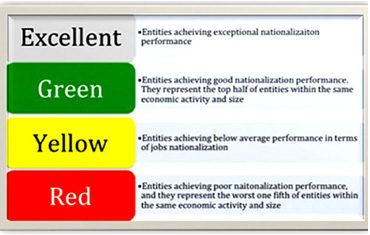
Figure 2: Saudisation requirement
within four categories for Nitaqat
(Source: Saudi Ministry of Labour)
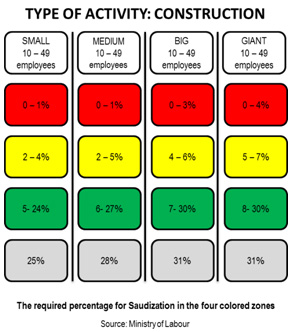
The firms that accepted Nitaqat and
entered the excellent and green zones
will be provided with an array of
facilities and motivations, making
it easier for them to deal with their
employees and workers' unions, besides
giving them sufficient flexibility
to achieve the desired levels of growth.
Furthermore, the program aims to
create a much-needed balance between
the advantages of hiring a foreign
worker and a Saudi worker by raising
the cost of maintaining foreign workers
in the red and yellow zones. Also,
Nitaqat is a monitoring tool for the
Saudi labour market, one which aims
for more localisation of jobs in the
private sector and reducing the country's
unemployment rate. In this study 45
companies located in the green, yellow,
and red zones were contacted with
an official letter from the University.
Twenty companies agreed to participate
in the study from three categories
- green, yellow and red zones. Finally,
just 13 companies were interviewed
during the given timeframe. Their
classifications are as follows: four
companies in the green zone; five
companies in the yellow zone; and
four companies in the red zone. This
paper presents the analysis and discussion
from the interviews undertaken with
local and non-local employees regarding
the implementation of Nitaqat Program
in their companies.
Research Methodology
The overall aim of the study was to
review the literature of both Knowledge
Management and Human Resources Management
in order to find the links between
both of them and using these links
to support the employee replacement
process in Saudi Arabia, specifically
with the context of the Nitaqat program.
One of the main objectives of this
research was to investigate and document
the problems or barriers that Saudi
organisations may face while enforcing
Nitaqat. This study is considered
to be a Social Constructivism Approach
(case study, descriptive study, and
exploratory research) because it seeks
to document a particular interest.
For the purpose of obtaining necessary
data, the researcher employed qualitative
research techniques. This decision
was based on the rationale and objectives
of the study, the required depth of
the investigation and dominance of
"how" and "what"
questions. The above mentioned objective
was addressed by the in-depth case
studies. Tools to collect data included
semi-structured interviews, as well
as documentation and archival analysis.
Conducted case studies consists of
interviews with HR managers and KM
experts, local employees and non-local
employees in 5 large, 5 medium-sized
and 5 small companies in order to
collect the primary data. The five
economic sectors that were explored
are: construction; wholesale and retail
trade; manufacturing; agriculture,
forests, hunting and fishing; and
transport, storage and telecommunications.
These five sectors were considered
worthy as they include the majorities
of foreign labour in the private sector
in Saudi Arabia.
In this study 45 companies located
in the green, yellow, and red zones
were contacted with an official letter
from the University. Twenty companies
agreed to participate in the study
from three categories - green, yellow
and red zones. Finally, just 13 companies
were interviewed during the given
timeframe. Their classifications are
as follows: four companies in the
green zone; five companies in the
yellow zone; and four companies in
the red zone. The qualitative data
for this research were obtained from
individual face-to-face semi-structured
interviews with Nitaqat's manager
from the Saudi's Ministry Of Labour,
13 Saudi Human Resources managers
in the Saudi's private sector, 13
local Saudi employees, and 13 non-local
employees. Secondary sources were
Ministry of Labour documents and announcements
about Nitaqat program, and articles
in Saudi Arabian major newspapers
and specialist journals or magazines.
Analysis and
Discussion of interviews with Saudi
(local) employees about the Nitaqat
Program
Local employees are the Saudi national
employees who are working in the country's
private sector. Thirteen local employees
from the private sector were interviewed:
four from green zone companies, five
from yellow zone companies, and four
from red zone companies. The participants
were asked a number of questions.
The first question was about the Nitaqat
program and whether the program affected
the organisation during the implementation.
The responses were as follows (see
Table 1):
Table 1: Local employees and Nitaqat
program 1 of 5
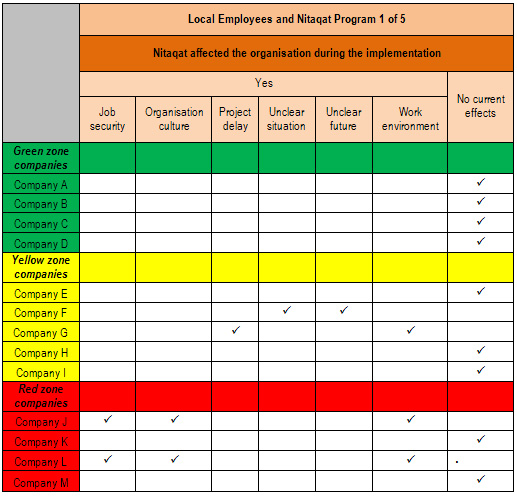
• Nine local employees (four
from the green zone, three from the
yellow zone, and two from the red
zone) said that the program did not
affect the work or the organisational
performance.
• Four local employees (from
yellow zone) said it indeed affected
the organisation. One of them said
that Nitaqat's impacts were felt in
the company's workplace due to delays
in some projects. Another yellow zone
local employee, but from a different
company, stated that the program affected
the firm as it is located in the yellow
zone and the current position of the
company is not clear, which might
affect his future career in his organisation.
• The case was the same with
red zone companies. Two local employees
said that the program affected the
organisational culture and environment,
and they were currently looking for
other jobs in case their bosses could
not find a way to move the business
to the green zone.
The local employees working in the
private sector were also asked about
the benefits of the Nitaqat program
to their companies. Nine local employees
(four from the green zone, four from
yellow zone and one from the red zone)
asserted that there were some benefits
of applying Nitaqat as follows (refer
to Table 2):
Table 2: Local employees and Nitaqat
program 2 of 5

• One local employee from the
green zone said that the program helped
define the Saudi private sector by
classifying the sectors in more detail.
• Two local employees (one from
the green zone and another from the
yellow zone) said Nitaqat will create
a competitive environment and help
in securing jobs for locals in the
private sector.
• Six local employees (one from
the green zone, four employees from
the yellow zone and one from the red
zone) stated that Nitaqat will create
job opportunities for locals and thus
increase the number of Saudis in the
private sector.
• Two green zone employees commented
that Nitaqat will facilitate the MOL's
services such as renewing non-locals'
visas and issuing new ones.
• Four local employees (1 yellow
zone employee and 3 red zone employees)
stated that Nitaqat delivered no benefits
to the company.
• All local employees in the
13 companies were asked if Nitaqat
regulations were introduced to them,
to which they replied in the affirmative.
The thirteen local employees were
asked about problems in regard to
localising jobs in Saudi Arabia and
they responded with the following
answers (see Table 3):
Table 3: Local employees and Nitaqat
program 3 of 5
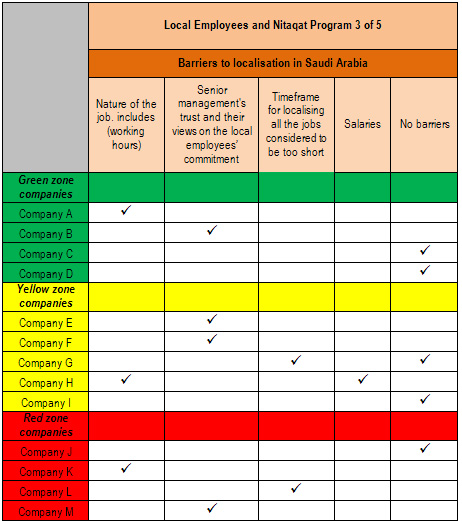
• Five locals (two green zone
employees, two yellow zone employees
and one red zone employee) believe
that there are no barriers to localising
all jobs in Saudi Arabia's private
sector.
• According to four locals (one
green zone employee, two yellow zone
employees and one red zone employee),
one challenge to localising jobs is
the lack of trust between senior management
and the locals; this needs to improve.
• Three locals (one local employee
from each zone) said that the nature
of the job itself was one such barrier.
They said some jobs in Saudi Arabia
will not be done by Saudis, such as
drivers or cleaners, and it is difficult
to recruit locals to carry out these
jobs. Others mentioned the odd working
hours of some jobs, such as call centre
operators.
• Two local employees (one in
the yellow zone and another one in
the red zone) believed that the time
frame that was specified by the MOL
to implement the program was too short.
• Only one local employee from
the yellow zone companies remarked
that the main barrier for localising
all jobs in the private sector was
salaries. This is because the salaries
of locals were much higher than that
of non-locals.
The local employees were also asked
about the barriers to localising jobs
in their companies (refer to Table
3). The answers did not differ much
from the previous question about the
barriers to localising jobs in Saudi
Arabia. Local employees in the participating
companies were also asked whether
there was an employee replacement
process in their companies. The responses
were varied (see Table 4):
Table 4: Local employees and Nitaqat
program 4 of 5
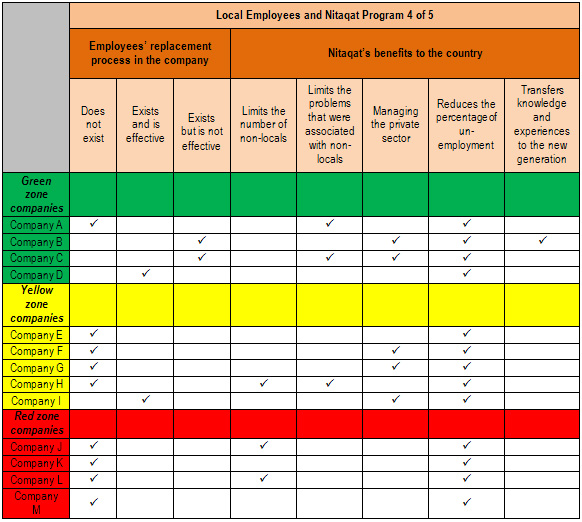
• Nine local employees (one from
the green zone, four from the yellow
zone, and four employees from the
red zone) said that there was no such
process.
• Two local employees (one from
the green zone and another one from
the yellow zone) said that the employee
replacement process did exist and
was quite effective in their workplace.
• Two local employees in the
green zone companies said the process
existed but was not effective.
Furthermore, the local employees
were asked about the benefits of the
Nitaqat program to the Kingdom of
Saudi Arabia:
• All 13 local employees across
different zones said the main benefit
of applying Nitaqat was reducing the
local unemployment rate. Again, this
was not surprising as it was the main
benefit that was linked to the program
when the MOL announced it.
• Five local employees (two from
the green zone and three from the
yellow zone) said that Nitaqat will
assist in defining and organising
the Saudi private sector.
• Three locals (one from the
yellow zone and two from the red zone)
said that the program helped in limiting
and controlling the number of non-local
employees.
• Three local employees (two
from the green zone and one from the
yellow zone) said that the program
will benefit the country by limiting
the problems associated with the non-locals,
which can result from social, cultural
and religious differences.
• One local employee in a green
zone company said Nitaqat will assist
in transferring knowledge and experiences
to the new-generation local employees
in Saudi Arabia.
Local employees were asked if the
knowledge they had acquired during
their time with their company belonged
to them or to the company:
• Nine employees (three green
zone employees, five yellow zone employees,
and one red zone employee) said that
the knowledge belongs to both the
company and the employee.
• Three employees from the red
zone said that the knowledge belongs
to the company.
• Only one employee from the
green zone said the knowledge belonged
to him.
Furthermore, all the Saudi (local)
employees were asked about the best
way to transfer knowledge:
• Eleven Saudi employees (four
green zone employees, five yellow
zone employees, and two red zone employees)
said that the best way to transfer
knowledge was training courses that
involved the "leaving employee"
as an instructor.
• Seven Saudi employees (two
green zone employees, three yellow
zone employees, and two red zone employees)
believed the best way was to offer
financial rewards.
• One employee from the yellow
zone said that the best way to transfer
knowledge was to implement new communication
tools that could help retain essential
knowledge in one accessible place
for all employees.
Table 5: Local employees and Nitaqat
program 5 of 5
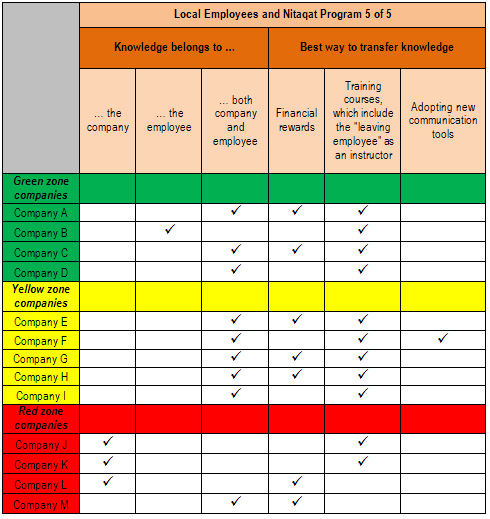
Analysis and
Discussion of interviews with Non-local
employees about the Nitaqat Program
The non-local employees
who participated in this study were
foreign employees working in the Saudi
private sector. They held an "employment
visa" enabling them to work in
their specific sector. Thirteen non-local
employees from the private sector
were interviewed: four from green
zone companies, five from yellow zone,
and four from red zone companies.
The participants were asked a number
of questions. The first question was
about the Nitaqat program and whether
the program affected the organisation
during the implementation (refer to
Table 6). Five non-local employees
(four from the green zone and one
from the red zone) said that Nitaqat
did not affect the work or the organisation's
performance. Non-local employees in
the green zone companies were not
affected by Nitaqat policies. However,
employees in the yellow and red zone
companies who have worked in the Kingdom
for six years have the right to work
for another employer in the excellent
or green zone companies as a reward
for their commitment to localisation.
This action has to be taken within
three months of the expiry of the
employment visa "Iqama"
or they will be deported. This rule
puts many non-local employees under
pressure and has led to an increase
in employee turnover in both red and
yellow zone companies.
Nine non-local employees (five from
the yellow zone and three from the
red zone) said Nitaqat affected their
business in the following ways:
• Three non-local employees (two
from the yellow zone and one from
the red zone) said that Nitaqat affected
their organisation's workplace environment.
This issue is linked with the next
point.
• Three non-local employees (two
from the yellow zone and one from
the red zone) said that Nitaqat affected
life at work by increasing the level
of stress, which led to a number of
problems for employees.
Cox and Britain (1993) define stress
as an interactive psychological state
between the individual (internal)
and the situation (external), which
can affect the individual's ability
to cope with the external situation.
Too much stress has many negative
outcomes and this issue has been discussed
by many scholars such as Cox and Britain
(1993), Cooper et al. (1996), Lazarus
(1995), Soylu (2007), and Rechter
et al. (2013). Nieuwenhuijsen et al.
(2010) and Mosadeghrad et al. (2011)
discovered evidence for a strong link
between stress, work environment,
and a number of factors including
high job demands, low job control,
low co-worker support, low supervisor
support, low procedural justice, and
low relational justice, as well as
external uncontrollable factors such
as governmental laws (for example,
the localisation program). They also
linked stress with many effects such
as turnover, absenteeism, aggression,
and hostility.
Three non-local employees (two from
the yellow zone and one from the red
zone) said Nitaqat affected the organisation's
future and made it appear uncertain.
In a recent Arab News (2014) article,
it was noted that 200,118 private
sector companies in the red zone (out
of 1.8 million companies in the private
sector) had closed down by 2013. The
MOL has confirmed this figure (MOL,
2013a). Notably, around 59% of those
firms were small and micro enterprises
that need to employ at least one Saudi
national. According to the MOL, the
number of medium-sized and large firms
that closed due to Nitaqat requirements
stood at around 200. The uncertain
future of red zone companies under
the new Nitaqat program was cited
by the non-local employees surveyed
in this study as a problematic outcome.
Table 6: Non-local employees and
Nitaqat program 1 of 4
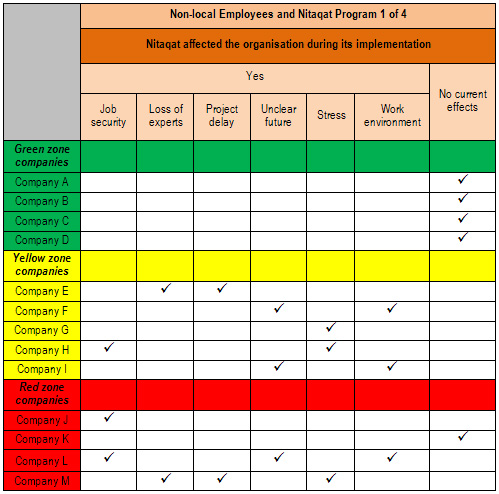
Three non-local employees (one from
the yellow zone and two from the red
zone) said Nitaqat affected not only
the company's future but also their
job security. On this theme, a study
by Kraimer et al. (2005) found that
job security wielded an influence
on the individual employee's performance.
The study also linked employees with
low job security, and cited a negative
relationship between threat perceptions
and supervisor's rating of a worker's
job performance. Luechinger et al.
(2010) noted that the significance
of job security for the private sector
employees was higher compared to public
sector employees. The study also shows
that the subjective well-being of
private sector employees is much more
sensitive to fluctuations in unemployment
rates compared to public sector employees.
Job security in Saudi Arabia's private
sector and how the Nitaqat program
affects it needs more investigation
in the future.
Two non-local employees (one from
the yellow zone and one from the red
zone) said that Nitaqat affected the
organisation as it led to employee
turnover resulting in the loss of
experienced and expert employees.
Abbasi and Hollman (2000, p. 333)
have defined employee turnover as
"the rotation of workers around
the Labor market; between firms, jobs,
and occupations; and between the states
of employment and unemployment".
Employee turnover is always expensive
and detrimental, and affects organisational
performance (Mueller & Price,
1989). Replacing the leaving employees
and selecting, recruiting and training
new ones costs a lot of time, money,
and effort (Mossholder et al., 2005).
Park and Shaw (2013) stated that the
relationship between total turnover
and organisational performance is
significant and has negative impact.
The reasons for employee turnover
have been discussed and listed in
many previous studies (Abbasi &
Hollman, 2000; Firth et al., 2004;
Mano-Negrin & Tzafrir, 2004; Ongori,
2007). These include job stress, lack
of commitment to the organisation,
extensive job pressures, job dissatisfaction,
low wages, powerlessness, economic
reasons, organisational instability,
poor personnel, toxic workplace environment,
poor HR policies and procedures, and
lack of motivation. Ongori (2007)
showed that employee turnover imposes
many difficulties on the company's
performance and can be considered
expensive due to the hidden costs
associated with paying the leaving
employees and hiring new ones. The
Nitaqat program has caused a huge
employee turnover in red zone and
yellow zone companies. Losing the
leaving employee's knowledge is one
of the most important issues that
these companies have to consider.
Two non-local employees (one from
the yellow zone and one from the red
zone) confirmed that Nitaqat affected
their organisation's performance by
causing project delays.
Non-local employees in the private
sector were asked about the benefits
of the Nitaqat program to their companies.
These were as follows (see Table 7):
Click here for
Table
7: Non-local employees and Nitaqat
program 2 of 4ocal
employees and Nitaqat program 2 of
4
• Nine non-local employees (five
from the yellow zone and four from
the red zone) said there was no noticeable
benefit from Nitaqat to the company.
• Four from in the green zone
said Nitaqat benefited the company
by facilitating MOL processes, such
as renewal of the employment visa.
• All non-local employees in
the 13 companies were asked whether
Nitaqat regulations were introduced
to them, to which they replied in
the affirmative.
Barriers to localisation from the
non-local employees' point of view
were evident. The 13 non-local employees
were asked about these problems. Their
responses were as follows:
• Six non-local employees (two
green zone employees, two yellow zone
employees and two red zone employees)
believed that lack of expertise amongst
Saudi nationals was one of the barriers
to localising jobs.
• Five non-local employees (two
green zone employees, two yellow zone
employees, and one red zone employee)
stated that the outcomes of the education
system are not related to the requirements
of the Saudi economy.
• Five non-local employees (one
green zone employee, two yellow zone
employees and two red zone employees)
said the nature of the job itself
was one of the barriers to localisation.
They said some jobs in Saudi Arabia,
such as drivers or cleaners, would
not be done by the locals.
• One employee from the yellow
zone cited the working hours of some
jobs as a barrier as Saudis were not
willing to work for longer hours or
during night shifts.
• Five non-local employees (two
green zone employees, one yellow zone
employee and two red zone employees)
said that the major barrier to localisation
were Saudi national citizens' high
salaries.
• Four non-local employees (two
yellow zone employees and two red
zone employees) said that the commitment
of locals to private sector jobs was
questionable. They had observed that
more time and effort was required
to trust young Saudi employees.
The non-local employees were asked
about the barriers to localising jobs
in the companies they were currently
working in. The answers were as follows
(see Table 8):
Table 8: Non-local employees and Nitaqat
program 3 of 4
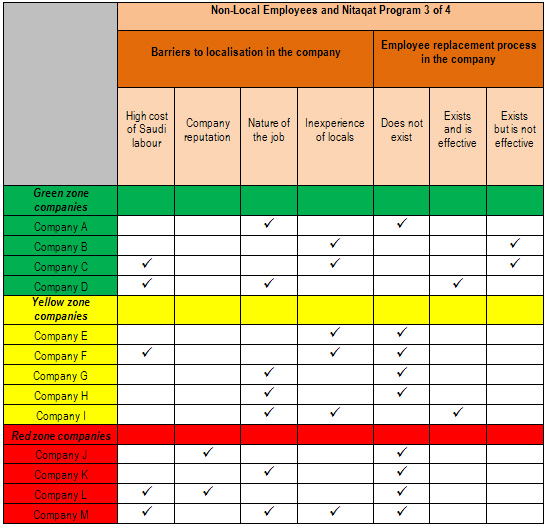
• Seven non-local employees (two
green zone employees, three yellow
zone employees and two red zone employees)
said that the nature of the job itself
was a barrier.
• Five non-local employees (two
green zone employees, one yellow zone
employee and two red zone employees)
said that the high cost of Saudi national
employees was a barrier.
• Six non-local employees (two
green zone employees, three yellow
zone employees and one red zone employee)
commented that the inexperience of
locals was a problem.
• Two non-local employees in
the red zone companies believed that
locals did not want to work in red
zone companies.
The non-local employees in participating
companies were also asked whether
there was an employee replacement
process where they worked:
• Nine non-local employees (one
from the green zone, four from the
yellow zone and four from the red
zone) said that there was no such
process in the company.
• Two non-local employees (one
from the green zone and one from the
yellow zone) said that the employee
replacement process did exist and
was effective in their workplace.
• Two non-local employees in
the green zone companies said the
process existed but was not effective.
The non-local employees were asked
about the benefits of the Nitaqat
program to the Kingdom of Saudi Arabia
(see Table 9):
Table 9: Non-local employees and
Nitaqat program 4 of 4
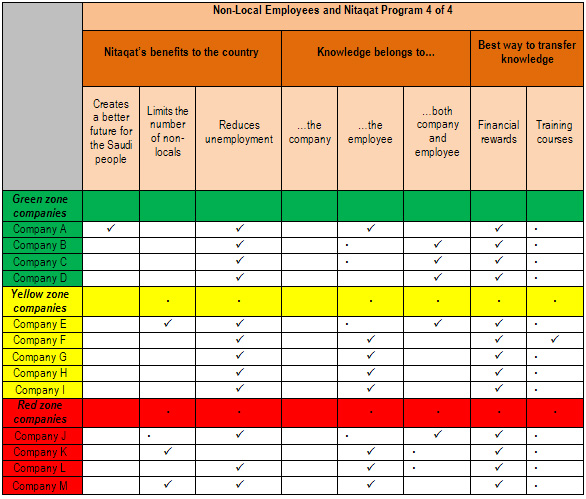
• All 13 non-local employees
across different zones said that the
main benefit from applying Nitaqat
was less local unemployment. Again,
this was not surprising as the same
answer was given by the local employees.
This benefit was always what the program
intended to do when the MOL announced
it.
• Three non-local employees (one
from the yellow zone and two from
the red zone) believed that Nitaqat
helped in limiting the number of non-locals
in Saudi Arabia.
• One non-local employee from
a green zone business believed that
Nitaqat will create a better future
for Saudi youth. The employee linked
it to the huge number of currently
unemployed locals and the crimes that
idle young Saudis were committing.
The employee believed that Nitaqat
will limit such problems associated
with unemployment.
The non-local employees were also
asked whether the knowledge they had
acquired during the time they had
spent with their respective companies
belonged to them or to the company:
• Eight non-local employees (one
green zone employee, four yellow zone
employees and three red zone employees)
said the knowledge belonged to them.
• 5 non-local employees (three
green zone employees, one yellow zone
employee and one red zone employee)
said that the knowledge belonged to
the company as well as the employee
themselves.
• Remarkably, none of them considered
that the knowledge belonged to the
company.
The final question that was put forward
to all non-local employees related
to the best way to transfer the knowledge
for outgoing foreign employees to
incoming local employees. Firstly,
all non-local employees (four green
zone employees, five yellow zone employees
and four red zone employees) commented
that the best way was to offer financial
rewards. Secondly, only one non-local
employee from a yellow zone firm mentioned
training courses besides financial
rewards.
Conclusion
Recognizing that lost knowledge through
replacing employees may be a threat
to organizations and country's economy
is a critical first step in addressing
this phenomenon. Retaining the needed
knowledge in organizations relies
on people and the ability of HR departments
in changing human behaviour. The success
of this endeavour depends on the commitment
of all HR managers in collaboration
with the departing employees and the
new ones. Human Resource Departments
are playing a major role as a strategic
partner for organizations and not
as supporting administrative departments
due to their role in facilitating
knowledge between employees. This
paper may only look at a very particular
part of the problem with the current
situation in Saudi Arabia and highlights
the role of knowledge management in
facilitating knowledge sharing. The
final conclusion from the interviews
undertaken with both local and non-local
employees suggests that there were
many common themes to which all of
them agree or disagree. All the employees
from the green zone companies responded
that there was no great impact of
Nitaqat program within their organisations.
All the employees working with the
red zone companies stated that Nitaqat
brings no benefits to their organisations
and all of them were worried about
losing their jobs. Whereas, all the
employees from yellow zone companies
were unclear about the current situation
and unsure about the future of their
companies. They all stated that Nitaqat
has resulted in project delays in
their organisations. Barriers to implement
the Nitaqat program includes; education
system's outcomes that is not in line
with industries' requirements; lack
of expertise among local Saudi nationals;
commitment of local employees to private
sector; odd working hours; blue collar
nature of the certain jobs; and private
sector salaries which were much lower
than salaries awarded by public sector
for similar job description, qualification,
and experience.
References
Bou-Llusar, C.J. and Segarra-Cipres,
M. (2006) 'Strategic knowledge transfer
and its implications for competitive
advantage: an integrative conceptual
framework', Journal of Knowledge Management,
Vol. 10, No. 4, pp.100-112.
Hippel, E. V. 1994. "Sticky Information"
and the Locus of Problem Solving:
Implications for Innovation. Management
Science, 40, 429-439.
Jennex, M. E., Smolnik, S. & Croasdell,
D. T. 2009. Towards a consensus knowledge
management success definition. VINE,
39, 174- 188.
Kidwell, J. J., Linde, K. M. V. &
Johnson, S. L. 2000. Applying corporate
knowledge management practices in
higher education. Educause Quarterly,
23, 28-33.
Maqsood, T. 2006. The Role of Knowledge
Management in Supporting Innovation
and Learning in Construction. PhD
Thesis. Doctor of Philosophy, Royal
Melbourne Institute of Technology
University.
Nonaka, I. 1994. A Dynamic Theory
of Organizational Knowledge Creation.
Organization Science, 5, 14-37.
Polanyi (1964) Personal knowledge:
Towards a post-critical philosophy,
Harper & Row.
Szulanski, G. 2003. Sticky Knowledge:
Barriers to Knowing in the Firm, SAGE
Publications.
|